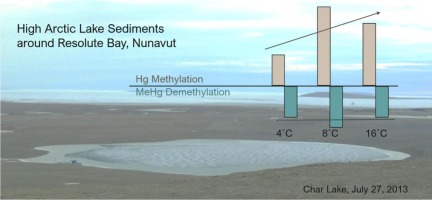当前位置:
X-MOL 学术
›
Chemosphere
›
论文详情
Our official English website, www.x-mol.net, welcomes your feedback! (Note: you will need to create a separate account there.)
Mercury methylation and demethylation potentials in Arctic lake sediments.
Chemosphere ( IF 8.8 ) Pub Date : 2020-01-23 , DOI: 10.1016/j.chemosphere.2020.126001 Karista E Hudelson 1 , Paul E Drevnick 2 , Feiyue Wang 3 , Deborah Armstrong 3 , Aaron T Fisk 4
Chemosphere ( IF 8.8 ) Pub Date : 2020-01-23 , DOI: 10.1016/j.chemosphere.2020.126001 Karista E Hudelson 1 , Paul E Drevnick 2 , Feiyue Wang 3 , Deborah Armstrong 3 , Aaron T Fisk 4
Affiliation

|
Mercury (Hg) transformations in sediments are key factors in the Hg exposure pathway for wildlife and humans yet are poorly characterized in Arctic lakes. As the Arctic is rapidly warming, it is important to understand how the rates of Hg methylation and demethylation (wich determine Hg bioavailability) change with temperature in lake sediments. Methylation and demethylation potentials were determined for littoral sediments (2.5 m water depth) in two deep and two shallow lakes in the Canadian Arctic using Hg stable isotope tracers at incubation temperatures of 4, 8, or 16 °C for 24 h. Compared to sediments from other regions, Hg methylation and demethylation potentials in these sediments are low. The maximum depth of the lake from which sediment was collected exerted a stronger influence over methylation potential than sediment Hg concentration or organic matter content; the shallowest lake had the highest Hg methylation potential. Sediments from the shallowest lake also demonstrated the greatest response to the temperature treatments, with significantly higher methylation potentials in the 8 and 16 °C treatments. Sediments from the deep lakes demonstrated greater demethylation potentials than shallow lakes. The methylmercury to total Hg ratio in sediments supported the measured transformation potentials as the lake with the greatest methylation potential had the highest ratio. This study supports previous works indicating that Hg methylation potential may increase as the Arctic warms, but demethylation potential does not respond to warming to the same degree, indicating that Hg methylation may predominate in warming Arctic sediments.
中文翻译:

北极湖沉积物中的汞甲基化和脱甲基化潜力。
沉积物中汞(Hg)的转化是野生动植物和人类接触汞的途径中的关键因素,但在北极湖泊中其表征却很差。由于北极地区正在迅速升温,因此重要的是要了解湖泊沉积物中汞的甲基化和脱甲基化速率(取决于汞的生物利用度)如何随温度变化。使用Hg稳定同位素示踪剂,在4、8或16°C的孵育温度下24小时,测定了加拿大北极地区两个深湖和两个浅湖中沿海沉积物(水深2.5 m)的甲基化和脱甲基电位。与其他地区的沉积物相比,这些沉积物中的汞甲基化和脱甲基化潜力较低。收集沉积物的湖泊的最大深度比沉积物的汞浓度或有机质含量对甲基化潜力的影响更大。最浅的湖泊具有最高的汞甲基化潜力。来自最浅湖的沉积物也显示出对温度处理的最大响应,在8和16°C处理中甲基化潜力明显更高。深水湖泊的沉积物显示出比浅水湖泊更大的去甲基化潜力。沉积物中甲基汞与总Hg的比率支持了测得的转化势,因为甲基化势最大的湖泊具有最高的比率。这项研究支持以前的工作,这些工作表明,随着北极变暖,汞甲基化潜力可能会增加,
更新日期:2020-01-23
中文翻译:

北极湖沉积物中的汞甲基化和脱甲基化潜力。
沉积物中汞(Hg)的转化是野生动植物和人类接触汞的途径中的关键因素,但在北极湖泊中其表征却很差。由于北极地区正在迅速升温,因此重要的是要了解湖泊沉积物中汞的甲基化和脱甲基化速率(取决于汞的生物利用度)如何随温度变化。使用Hg稳定同位素示踪剂,在4、8或16°C的孵育温度下24小时,测定了加拿大北极地区两个深湖和两个浅湖中沿海沉积物(水深2.5 m)的甲基化和脱甲基电位。与其他地区的沉积物相比,这些沉积物中的汞甲基化和脱甲基化潜力较低。收集沉积物的湖泊的最大深度比沉积物的汞浓度或有机质含量对甲基化潜力的影响更大。最浅的湖泊具有最高的汞甲基化潜力。来自最浅湖的沉积物也显示出对温度处理的最大响应,在8和16°C处理中甲基化潜力明显更高。深水湖泊的沉积物显示出比浅水湖泊更大的去甲基化潜力。沉积物中甲基汞与总Hg的比率支持了测得的转化势,因为甲基化势最大的湖泊具有最高的比率。这项研究支持以前的工作,这些工作表明,随着北极变暖,汞甲基化潜力可能会增加,



























 京公网安备 11010802027423号
京公网安备 11010802027423号